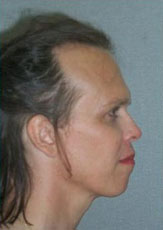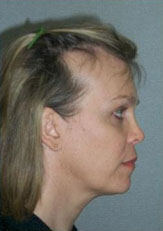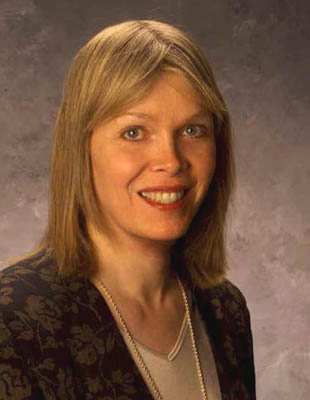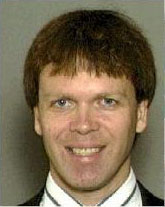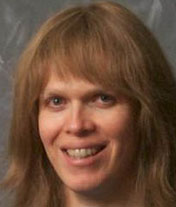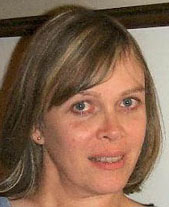-
-
-
A Cirurgia de Feminilização
Facial (CFF)
de Lynn
Copyright © 2000-2010,
Lynn
Conway
Todos os direitos reservados
[versão de 20.10.10]
(em inglês)
Traduzido por
Sonia John
Revisado por
Adriana Carvalho
|
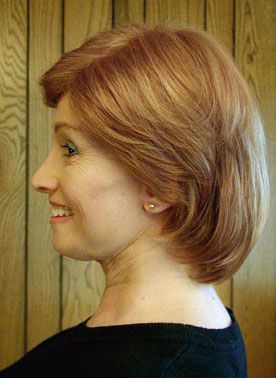 |
Foto de Lynn depois da CFF: 29 de
março de 2000
|
-
Em 10 de novembro de 1999,
Lynn Conway
(Pt) se submeteu à
cirurgia de feminilização facial (CFF). O Dr. Douglas Ousterhout, M.D.,
D.D.S., executou essa cirurgia de dez horas no campus Davies do Centro
Médico California-Pacific em São Francisco. O Dr. Ousterhout é o pioneiro
nesse campo de cirurgia muito agressiva de reconstrução dos ossos faciais de
mulheres transexuais.
O objetivo da cirurgia de feminilização facial é eliminar
ou reduzir muitos dos traços masculinos dos ossos faciais, que são
provocados pelos altos níveis de testosterona presentes durante a fase final
da puberdade nas transexuais MtF (Male to Female—de homem para
mulher). Para visualizar o que já é possível, leia sobre as experiências
cirúrgicas e veja as extraordinárias fotos do antes/depois nos sites de
Andrea James,
Becky Allison,
Gina,
Madeleine,
Nicki,
Sally e
Rachel,
todas elas pacientes do Dr. Ousterhout. Veja também a
Página de Diane sobre sua CFF com o Dr. Ousterhout
e
a
Página de CFF do site beginninglife.com
para mais links de fotos e histórias sobre a CFF.
Já que aumentou o número de mulheres transexuais que se submeteram a
essas cirugias ao início deste século, as vantagens se tornaram óbvias.
Como resultado, surgiu a necessidade de que essas cirurgias sejam mais
disponíveis e apoiadas, o que expressa Andrea James em sua
mensagem pública do 16 de junho de 2006 à HBIGDA:
"Exorto que a HBIGDA, tanto quanto outros conselheiros
profissionais, enfatice mais nas Normas de Cuidado a importância do
rosto e a voz, e sugiro em especial que os senhores/as advoguem a
necessidade médica desses procedimentos de feminlização facial para elas
expostas a androgênios durante a puberdade..."-
Andrea James
Esta página fornece informação detalhada, um diário de
acontecimentos e algumas fotos da experiência cirúrgica da CFF de Lynn, na
esperança de que essa informação seja valiosa para quem esteja contemplando
a sua própria CFF.
-
-
-
-
-
-
-
-
-
-
INFORMAÇÕES SOBRE A CFF:
-
Nos fins dos anos oitenta, o Dr.
Douglas Ousterhout chegou à conclusão de que os efeitos da masculinização
nos rostos das transexuais MtF podiam desfigurá-las e exclui-las socialmente
tanto quanto os efeitos de deformações genéticas nos rostos de crianças, ou
naqueles que sofriam acidentes. O Dr. Ousterhout, que tinha experiência
extensa em cirurgia estética, craniofacial, maxilofacial e reconstrutiva,
junto com uma ampla gama de “macetes” cirúrgicos que podia utilizar para
solucionar tais problemas, abriu novos caminhos na reconstrução radical dos
rostos de mulheres transexuais.
Descrevem-se muitas das técnicas cirúrgicas da CFF no
livro de consulta médica Esculpindo Estéticamente o Esqueleto
Craniofacial, do Dr. Douglas K. Ousterhout, Ed., 1991. Essas técnicas
ultrapassam em muito a cirurgia estética tradicional (como se pode ver
nos
esboços e fotos, no livro mencionado acima, da remoção e remodelagem de
grande parte da testa e dos ossos das órbitas dos olhos
para eliminar um perfil muito masculino das
sobrancelhas).
No caso das mulheres
transexuais, o Dr. Ousterhout enfoca a modificação levando em conta as
dimensões de cada rosto para que o resultado chegue o mais próximo possível
das proporções femininas, e para isso, baseia-se em medidas antropológicas.
A necessidade de sobrevivência tem influenciado a evolução, resultando na
adaptação dos rostos masculinos para a proteção durante a luta e a caça,
através do desenvolvimento de arestas nas sobrancelhas, assim como queixos e
mandíbulas grossos. Os rostos femininos (e também os de crianças), em
contraste, evoluíram para que elas pudessem fugir e se esconder melhor
(faltam-lhes as arestas das sobrancelhas além de seus olhos estarem mais
adiante na estrutura facial, o que lhes dá melhor visão periférica). Essas
diferenças das características sexuais secundárias se desenvolvem como
resultado da presença de hormônios diferentes nos corpos de meninos e
meninas depois do começo da puberdade.
-
A influência
da testosterona, o hormônio masculino, produz uma masculinização rápida dos
traços faciais dos meninos, que começa durante a puberdade e continua
durante os vinte; também resulta no aparecimento da barba e na mudança do
tom da voz. A remoção da fonte de tesosterona (pela castração) impede essa
masculinização, o que se pode ver nos
perfis de duas hijras do site de Takeshi Ishikawa (durante
muitos séculos muitas transexuais da Índia se submeteram como adolescentes à
castração e à emasculação completa ao se juntar à casta hijra; depois vivem
como “mulheres” em “famílias” hijras). Faltam às duas hijras na foto de
Ishikawa as saliências das sobrancelhas, elas têm pequenos queixos e
mandíbulas, além de testas que se fusionam de maneira suave à linha do
nariz. Sem a influência da testosterona, os traços faciais permanecem
infantis, e parecem com os de outras mulheres jovens, embora em geral as
hijras não tenham acesso a hormônios femininos.
Como se pode ajudar mulheres transexuais obrigadas pelas
circunstâncias a crescer como homens e sofrer a masculinização do rosto?
Pode-se levar a cabo a feminilização cirúrgica de rostos masculinizados ao
reduzir ou eliminar a saliência das sobrancelhas, redimensionar a testa,
ajustar o contorno do nariz, reduzir o tamanho do queixo e da mandíbula,
assim como esculpir a traquéia para eliminar o pomo-de-adão. Contudo, como
na cirurgia reconstrutiva de vítimas de acidentes e meninos com fissura
palatal, essa cirurgia é extremamente invasiva.
-
-
-
-
Esta transformação é muito profunda, e Madeleine já se torna uma
mulher bonita.
|
-
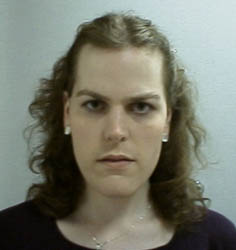
|
-
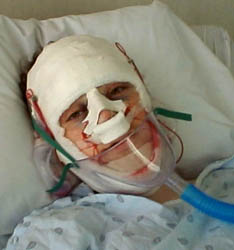
|
-
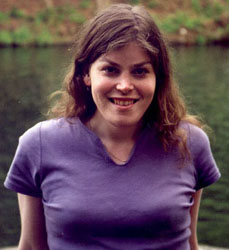
|
-
Uma pessoa não se submete à dor de
uma cirurgia tão extrema só por “motivos estéticos”. A paciente deve estar
altamente motivada e ser capaz de aceitar os riscos reais de tolerar dores,
sofrimento e complicações. O período de recuperação pós-operatória é
doloroso e traumático, e seqüelas permanecem durante muito tempo — é comum
que o inchaço dos ossos faciais e o entorpecimento do queixo tardem meses
até se reduzir, e que áreas do couro cabeludo percam sensibilidade por um
ano ou mais, ou até permanentemente.
No entanto,
em alguns casos de transexuais que tenham saliências nas sobrancelhas e
mandíbulas muito grandes, pode-se dizer que a CFF é quase a diferença entre
uma vida razoável e uma morte em vida, ou seja, entre ser aceita como uma
mulher normal ou ridicularizada pela aparência. Em muitos casos típicos, a
cirurgia substitui os traços originais do “rosto transexual” por contornos
agradavelmente femininos.
Leve em
consideração por exemplo o caso de
Sally,
mostrada nas três fotos seguintes. A primeira foto (à esquerda) a mostra
ainda como um rapaz, e um rapaz bastante bonito. A segunda foto a mostra
depois de dois anos de tratamento hormonal e de eletrólise. Muitas mulheres
transexuais se sentiriam felizes de ter-se transformado até esse ponto, e
muitas poderiam achar que já têm até um aspecto bom nessa fase.
Entretanto, embora se perceba que os traços faciais tenham-se suavizado e
sejam um pouco mais femininos na segunda foto, pode-se ver também que ela
ainda tem certa aparência de transexual. As arestas das sobrancelhas, o
queixo alto e a mandíbula larga — que faziam dela um rapaz bonito — já
estragam o aspecto feminino. A terceira foto a mostra depois da CFF
executada pelo Dr. Douglas Ousterhout, M.D. Já percebemos melhor os
problemas da segunda foto, e por que ela não parecia bonita. A
transformação da CFF, embora aparentemente sutil, é realmente profunda. Já é
uma mulher de beleza impressionante, mesmo sem maquiagem. Esse é um
resultado excelente, mas nem todos serão tão impressionantes. Contudo, o
resultado é muitas vezes essencial em termos de auto-estima, sobretudo na
capacidade de se passar naturalmente como uma mulher.
-
-
-
-
Fotos de Sally:
Antes da transição/depois de dois anos de hormônios e eletrólise/depois da
CFF pelo Dr. Ousterhout
-
-
O que
aconteceu? Como a aparência dela mudou tanto? A resposta se descobre ao
olhar as mesmas mudanças de PERFIL. Embora não nos olhamos de perfil quase
nunca, assim é como os demais muitas vezes nos vêem. E é a estrutura facial
de perfil, em ângulos intermediários, que mais determina a aparência de
nossos rostos e as opiniões que os demais terão sobre nosso gênero. Por
isso, é nosso perfil que mais freqüentemente nos revela como transexuais e
impede que pareçamos bonitas.
As duas fotos seguintes mostram o perfil de Sally antes e depois da CFF. As
mudanças são realmente incríveis. Embora tivesse um aspecto razoável de
frente, a aparência dela de perfil antes da cirurgia era muito inadequada
para uma mulher. Depois da CFF, a aresta das sobrancelhas desapareceu e foi
substituída por um contorno redondo tipicamente feminino; o nariz foi
esculpido para se unir suavemente à testa remodelada; a altura e o ângulo.
-
-
- Fotos de perfil de Sally antes e depois da CFF:
-
-
-
- Essas fotos de PERFIL revelam claramente as mudanças dramáticas da
estrutura facial como resultado da CFF. Essas mudanças da estrutura óssea
podem desfazer muito do dano causado pela testosterona durante a puberdade.
Sally finalmente tem os traços faciais que teria tido se tivesse
experimentado a puberdade como uma garota, com estrogênio em vez de
testosterona no corpo. Os resultados são maravilhosos e capazes de mudar a
vida, como se pode ver na foto seguinte. Esses resultados indicam também o
quão importante é que nossa sociedade ajude as mulheres transexuais cedo na
vida, para que se evite o desenvolvimento de rostos tão masculinizados que
só possam ser corrigidos mais tarde por cirurgias muito dispendiosas e
dolorosas.
-
-
-
Sally—agora uma linda mulher
-
-
-
Em muitos
sentidos, a inovação da CFF está causando um impacto dramático nas vidas de
mulheres transexuais, e em suas oportunidades de encontrar felicidade, do
mesmo modo como fez o desenvolvimento das técnicas da SRS (Sex
Reassignment Surger y -- cirurgia de redesignação sexual). A mulher que
pode reverter a masculinização do rosto experimenta como resultado algo
muito mais profundo do que um simples exercício de vaidade ou
embelezamento. Quer dizer, essas cirurgias muito invasivas têm um papel
importante na auto-aceitação das mulheres transexuais, em finalmente
permiti-las encontrar um lugar cômodo e apropriado dentro da sociedade após
a recuperação. Para entender mais esse processo, veja o artigo de
Rebecca Kastl
intitulado
“Passar ou não passar”
e, em seguida, leia abaixo as palavras de minha amiga
Emily Hobbie:
“Quando saía de casa antes da cirurgia, não importava
quanta alegria e paz eu irradiasse — alguns sempre me veriam como uma pessoa
esquisita. No falo de poder passar despercibida—falo de como as pessoas me
viam enquanto ser humano. Quero que as pessoas me vejam claramente, sem
olhar por uma lente de dúvidas para tentar enxergar quem porventura eu
seria. Não importava quão feliz e otimista eu fosse antes da CFF, as linhas
e curvas do meu rosto, que não me pertenciam, arruinavam minha confiança —
eram tão erradas como uma mecha de cabelo rebelde que de nenhum jeito
pode-se domar.
Estou certa de que, se não existisse a cirurgia que
executa o Dr. Ousterhout, assim mesmo eu teria tentado tirar o melhor
proveito possível da vida. Mas suponho que, apesar de toda a felicidade que
eu tivesse conseguido obter, a diferença entre quem sou e quem meu rosto
dizia que eu era teria roubado muito da minha alegria de viver. Quem sabe?
Resultados à parte, isso não só me permite integrar-me ao
mundo e à sociedade — que é o melhor que podia esperar de antemão — mas
também abraçá-la positivamente e encontrar a paz por dentro (ou a
possibilidade de tê-la), que os demais vêem e percebem. É um maravilhoso
ciclo ressonante: a sensação de conforto sentida por mim irradia-se para os
demais, que percebem meu equilíbrio e voltam a refletir a felicidade para
mim...”
Com a difusão das notícias das transformações faciais
entre a comunidade transsexual e entre os psicoterapeutas delas, a clientela
do Dr. Ousterhout cresceu muito em meados e fins dos anos 90. As notícias
espalharam ainda mais rapidamente quando fotos de “antes/depois” começaram a
aparecer em sites, junto com conselhos sobre como se preparar e enfrentar
uma cirurgia tão agressiva.
Andrea James foi a primeira
mulher transexual que publicou fotos desse tipo na internet. Essas fotos
animaram Nicki, Sally, Lynn e muitas outras mulheres transexuais a encarar o
conceito de CFF, as quais logo decidiram se submeter à cirurgia. Até o maio
de 2001, o Dr. Ousterhout tinha executado aproximadamente de 525 a 550
cirurgias de reconstrução facial para pacientes transexuais.
-
Muitas mulheres transexuais que planejam uma transição já
se submetem à CFF imediatamente antes do começo da “experiência da vida
real”. Isso pode melhorar muito a aceitação imediata como mulheres durante
a experiência de transição porque aparentam mais femininas depois da CFF.
Note que
Andrea,
Becky,
Gina,
Madeleine,
Nicki,
Sally e
Rachel se submeteram à CFF
com o Dr. Ousterhout quando estavam nas etapas iniciais ou intermediárias
das transições sociais.
Uma melhor aceitação social durante a experiência da vida
real possibilita que muitas mulheres transexuais se transicionem socialmente
de homem para mulher em seus empregos e assegurem, desse modo, a fonte de
renda enquanto se preparam para se submeter à SRS depois da experiência da
transição. Embora a CFF seja bastante onerosa, o fato de poder evitar a
perda do emprego pode compensar o custo da cirurgia. Adicionalmente, já
sabemos que se pode deduzir os custos da CFF da renda pessoal ao se calcular
o imposto de renda, porque a CFF é considerada uma parte do processo médico
global de redesignação sexual e não uma cirurgia meramente estética.
O consultório do Dr. Ousterhout está
localizado no campus Davies do Centro Médico California-Pacific. O endereço
é: Dr. Douglas Ousterhout, M.D., D.D.S., 45 Castro St., Suite 150, San
Francisco, California 94114, USA/EUA. O número de telefone é
(415) 626-2888, e o endereço eletrônico é
e-mail link.
Sugere-se para quem deseje marcar uma hora com o Dr. Ousterhout ligar para
seu escritório e falar com sua assistente, Mira Coluccio. Para mais
informações sobre o Dr. Ousterhout e suas técnicas cirúrgicas, veja o site
http://www.drdouglasousterhout.com/
-
-
-
O MOTIVO DE LYNN TER-SE SUBMETIDO À CFF:
-
Lynn, que tem mais de 55 anos, é uma mulher transsexual
pós-operada que se submeteu à SRS de homem para mulher (MtF) há bastante
tempo, em 1968. Ela teve a sorte de sempre poder passar facilmente como
mulher, e ter desfrutado de uma carreira e uma vida maravilhosas como tal.
Entretanto, Lynn nunca conseguiu
esquecer os horríveis efeitos da masculinização facial que começaram
enquanto ela era adolescente, embora tais efeitos tenham sido menos visíveis
que nos casos de muitas outras transexuais. A CFF moderna lhe permitiu
“reverter o tempo” e desfazer uma grande parte dos danos físicos dessa
experiência terrível. Em resumo, Lynn se submeteu à CFF para melhorar sua
vida e trazer alívio psíquico e felicidade enquanto amadurece.
A CFF de Lynn incluiu avanço da linha capilar,
remodelagem da testa, eliminação das arestas das sobrancelhas, reconstrução
do nariz, da mandíbula e do queixo e redução da traquéia, tudo executado no
curso de uma longa cirurgia que as pacientes do Dr. Ousterhout chamam de “o
serviço completo”. Os resultados são sutis e ao mesmo tempo incríveis.
Lynn ainda “parece Lynn”, especialmente de frente, mas de perfil ocorreu uma
transformação notável. Lynn agora se parece como uma irmã sua pareceria,
caso tivesse tido alguma.
Lynn espera que as informações e experiências aqui
documentadas ajudem aquelas que pretendem se submeter a esse tipo de
cirurgia. Se você tem essa intenção, ou se tem outras perguntas específicas
a respeito de CFF, pode contatar Lynn pelo endereço de e-mail que se
encontra na página inicial. Lynn também tenta manter este site tão
atualizado e útil quanto possível. Se você tem qualquer comentário,
correção ou sugestão, por favor entre em contato com ela.
Para mais informação sobre Lynn, inclusive muitas outras fotos da vida dela,
visite
http://www.lynnconway.com.
O site seguinte inclui artigos de imprensa sobre a vida e a carreira dela:
http://ai.eecs.umich.edu/people/conway/Media/Media.html.
Pode-se também
ler a retrospectiva detalhada da vida dela em
http://ai.eecs.umich.edu/people/conway/RetrospectiveT.html
-
-
- A DECISÃO E OS PREPARATIVOS:
-
Sempre gostei de estar ao ar livre, e ao longo dos anos
tenho praticado muita trilha, alpinismo, corrida, canoagem e motociclismo.
Meu rosto e pele, expostos ao sol e ao clima durante tantos anos, junto com
o processo natural de envelhecimento, desenvolveram muitas rugas. No início
de 1999 comecei a procurar informações sobre cirurgia estética para
rejuvenescer minha aparência.
Também procurei nos sites Web de outras mulheres
transexuais informações sobre cirurgia facial e me deparei com as fotos
incríveis do site de Andrea James. Ao olhar as fotos do antes/depois de
Andrea e de outras pacientes, especialmente as de perfil, entendi quanto os
traços da saliência das sobrancelhas, da mandíbula e do queixo influenciam
na aparência das transexuais MtF. Instantaneamente, entendi o conceito de
CFF e vi o quanto o Dr. Ousterhout tinha desenvolvido essas novas técnicas
cirúrgicas.
Durante uma viagem à Califórnia em junho de 1999,
consultei o Dr. Ousterhout para saber como ele poderia me ajudar. Como Mira
me havia instruído, mandei tirar raios-x do meu rosto no dia anterior em um
laboratório no centro de São Francisco. Logo após, o Dr. Ousterhout me
examinou, analisou as radiografias e discutimos todas as opções possíveis.
Escutei cuidadosamente todas as recomendações iniciais que ele esboçou sobre
as chapas a respeito das mudanças que ele sugeria na minha testa, arestas
das sobrancelhas, nariz, mandíbula e queixo. Ao me dar conta da melhora que
era possível, comecei a pensar seriamente em fazê-lo. Depois de voltar para
casa, pesquisei mais ao entrar em contato por e-mail com ex-pacientes do Dr.
Ousterhout para saber mais das experiências e dos resultados delas.
Em meados de julho decidi que realmente necessitava dessa
cirurgia. Precisaria de um lifting de qualquer jeito, e era óbvio que seria
um erro fazê-lo sem antes remodelar os ossos faciais, já que eu perderia os
efeitos do lifting se mais tarde decidisse me submeter à CFF.
Eu tinha me
submetido a várias cirurgias ao longo dos anos, mas era óbvio, depois de ter
lido sobre as experiências das outras pacientes, que a CFF seria uma
experiência bem mais traumática se
comparada com minhas experiências anteriores. Seria mais difícil até do que
a SRS típica. Entretanto, tinha aprendido que a pessoa que esteja preparada
mentalmente para enfrentar a dor e a trauma, não deixando que isso a afeite
psicologicamente, acaba por esquecer rapidamente toda a experiência ruim.
No meu caso, me parecia que os benefícios facilmente compensariam o
sofrimento.
Voltei a visitar o Dr. Ousterhout em agosto de 1999 para uma consulta de
planejamento detalhado. Decidimos que me submeteria ao “serviço completo”,
quer dizer, à série de cirurgias faciais executada de uma única — e longa --
vez. Marcamos a data para 10 de novembro e, então, fiz o depósito. Aquilo
estava mesmo para acontecer.
-
Entre agosto e outubro tive a oportunidade de conhecer
Sally e
Nicki,
duas mulheres transexuais que tinham se submetido ao “serviço completo” com
o Dr. Ousterhout. Surpreendeu-me saber quanto
lhes tinha ajudado a cirurgia, e aprendi muito com elas sobre a cirurgia e o
processo de recuperação. Adicionalmente, elas me deram muitos conselhos
sobre a preparação, o que devia levar comigo, e dicas práticas sobre o
hospital e a vizinhança, além de muita informação sobre o que podia esperar
durante minha recuperação.
Por exemplo, por ter conversado com Sally e Nicki e
outras pacientes, e também por ter lido muito na internet, comecei a me
preocupar com a claustrofóbia de ficar cinco dias com um tamponamento no
nariz. Para tentar me tranqüilizar, fiz uma simulação: jantei e dormi uma
noite inteira com um pregador (do tipo que os nadadores usam) preso nele.
Era difícil comer e beber, me dava trabalho engolir, e meus ouvidos
estalavam o tempo todo, mas ao fim me acostumei. Claro que ia ser um grande
incômodo, mas eu concluí que poderia tolerar o tamponamento de meu nariz.
Enquanto fazia as malas, pensava no que levar comigo e
planejava a viagem e o período de recuperação; extraí muita informação dos
sites de outras ex-pacientes. Havia muitas duvidazinhas sem respostas, e
muitas outras que já nem sabia questionar. Decidi escrever um diário de
minhas experiências para poder compartilhar mais tarde.
[Nota: algumas das fotos abaixo são bastante chocantes, mas as incluí para
que pacientes em potencial se dêem conta de como ficarão durante a primeira
etapa da recuperação. Espero que elas sirvam para reduzir o choque inicial
quando a paciente se olhar pela primeira vez no espelho.]
-
-
-
-
- NOTA
IMPORTANTE SOBRE A PENSÃO DE RECUPERAÇÃO "COCOON HOUSE":
-
Quando me liberaram da Unidade de Terapia Intensiva (UTI)
do Hospital Davies, dois dias depois que me submeti à CFF, tive várias
opções de alojamento para mais ou menos uma semana de recuperação. Havia
alguns hotéis perto (veja
aqui) e os chamados "quartos de
hóspedes" do Hospital Davies, os quais, nessa época, eram em um andar não
ocupado do hospital. Custavam US$60 por dia e podia-se ter três refeições
hospitalares diárias.
Os quartos eram convenientes e muito perto do consultório
do Dr. Ousterhout, mas também tinham desvantagens -- algumas pacientes se
sentiam muito isoladas nesse andar não ocupado. Adicionalmente, havia
pacientes que não gostavam da comida hospitalar. Em dezembro de 2000, o
hospital começou a precisar desses quartos novamente e o Dr. Ousterhout teve
que providenciar um novo alojamento para recuperação pós-operatória: a
Pensão Cocoon, que pertence a duas enfermeiras cirúrgicas do Hospital
Davies. Mary-Lou, uma das donas, me enviou o e-mail seguinte para divulgar
que a pensão tinha sido inaugurada:
Lynn, gostaria de nos apresentar a você: sou Mary-Lou e minha
sócia é Trícia. Somos enfermeiras e trabalhamos na sala de cirurgias do
Hospital Davies. Quando ouvimos que fechariam os quartos de hóspedes do
hospital, decidimos converter nossos dois apartamentos em uma pensão para as
pacientes do Dr. Ousterhout. Nosso objetivo é fornecer um ambiente que seja
seguro, confortável, livre de fumo e acolhedor. Não oferecemos serviços de
enfermeira, mas cuidamos de nossas hóspedes! Fornecemos alimentos para
pacientes que se recuperam da CFF (por exemplo, sucos, água emgarrafada,
gelatinas, pudim, porções de frutas, sopas e picolés). Cada quarto tem uma
televisão com vídeo, aparelho de som com CD, telefone (só para ligações
locais), forno, geladeira, microondas, liqüidificador, máquina de café,
secador de cabelos e cofre. Os hóspedes podem desfrutar de um aprazível
pátio, onde há um limoeiro. A pensão está localizada aproximadamente a uma
milha (1,6 km.) do Hospital Davies. O transporte público é muito
conveniente e custa US$1.00. A vizinhança (Vale de Noé) é culturalmente
diversa e conhecida pela solidariedade. Diferentemente da maior parte da
cidade, nós estamos numa área plana! Pode-se encontrar mercados,
restaurantes e quase todos os tipos de lojas e serviços muito perto da
casa. Atenciosamente, Mary-Lou.
A um custo de US$ 125 por dia, mais ou menos, a Pensão Cocoon fornece
alojamento aprazível, refeições e acesso fácil e prático ao cuidado pessoal
durante a recuperação. Isso realmente é algo maravilhoso. Para mais
informações, assim como reservar alojamento para antes e/ou depois da CFF,
ligue para Mira Coluccio no consultório do Dr. Ousterhout.
-
- No diário abaixo, conto minha própria experiência que incluiu me alojar em
um dos quartos anteriormente fornecidos pelo Hospital Davies. No futuro,
aquelas que se submeterem à CFF deverão levar em conta a diferença de se
alojar na Pensão Cocoon (ou em um hotel) quando se recuperarem depois de
sair da Unidade de Terapia Intensiva (UTI). Pode-se ler mais sobre a
referida hospedagem no Site Web da Pensão Cocoon.
LINKS PARA MAIS INFORMAÇÕES SOBRE A CFF:
Desde que escrevi
esta página em 2000, cada vez mais mulheres transexuais têm se submetido à CFF
para completar suas transições de gênero de modo mais fácil e bem-sucedido.
Como resultado, um grande número de cirurgiões-plásticos eminentes ao redor do
mundo começaram a praticar esse tipo de cirurgia facial introduzido pelo Dr.
Ousterhout, tornando-se peritos nela. Cada vez mais, mulheres transexuais estão
colocando suas histórias e fotos da CFF na internet, a fim de que outras
transicionistas entendam melhor os custos, os riscos e as recompensas e
meios-termos resultantes desse tipo de cirurgia. Isso conduziu a uma
disponibilidade cada vez maior de dados sobre a CFF na internet. Os links
seguintes a ajudarão a explorar toda essa informação:
Página de informação de Andrea James sobre CFF, com links
muitas fontes de informação sobre CFF.
Página “Beginning Life” sobre CFF, com muitos links de
histórias e fotos de pacientes de CFF, bem como sites de cirurgiões eminentes em
CFF.
Página de Diane sobre a Cirurgia de CFF com o Dr. Ousterhout.
Site europeu de informação transexual: fornece informações
sobre cirurgiões de CFF (e SRS) em muitos países (e em muitos idiomas).
Informações sobre Feminilização Facial.
Grupo de Apoio
CFF Yahoo
Vicki Estrada's photo-diary
video about her Facial Feminization Surgery with Dr. Spiegel in Boston
NEW
Victoria Escher's page about
her FFS with Dr. Ousterhout (including
before/after photos)
NEW
Sites de cirurgiões eminentes
de CFF:
Douglas Ousterhout, M.D., San
Francisco, CA
Jeffrey Spiegel, M.D.,
Boston, MA (link to FFS page,
also see many photos at
this link)
Mark L. Zukowski, M.D.,
Chicago, IL
Frans Noorman van der
Dussen, M.D., Antwerp, Belgium
Suporn Watanyusakul, M.D.,
Chonburi, Thailand
Bart van de Ven, M.D., Ghent,
Belgium (procedures,
before/after photos,)
NEW
Marcelo Di Maggio,
M.D., Buenos Aires, Argentina (more,
more,
more,
more,
more,
more)
NEW
- AGRADECIMENTOS:
-
Muito obrigada ao Dr. Douglas Ousterhout por entender e
se preocupar com os problemas de masculinização dos rostos de mulheres
transexuais, por se empenhar em utilizar o espíritu criativo e inovador dele
para solucioná-los, assim como por empregar uma inigualável destreza
cirúrgica para feminilizar artisticamente os rostos de tantas mulheres
transexuais.
Obrigada também à chefe do consultório do Dr. Ousterhout,
Mira Coluccio,
que tem uma relação muito próxima com todas as pacientes, a fim de ajudá-las
a se preparar para a cirurgia e amenizar suas recuperações. Ela
eficientemente dirige o grande consultório do Dr. Ousterhout para que este
funcione sem problemas. Quero também agradecer a Andrea James,
Sally,
Nicki,
Jessica e Carolyn por terem me dado tanta ajuda pessoal e tanto ensino sobre
websites enquanto me preparava para a minha CFF.
-
-
-
| O Dr. Douglas Ousterhout, M.D.,
D.D.S. |
A ajudante do Dr. Ousterhout, Mira Coluccio
|
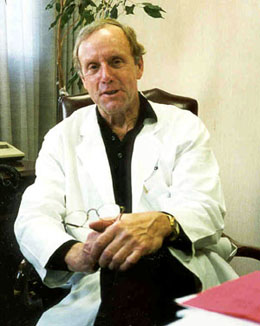 |
 |
-
-
- DIARY OF MY
FFS SURGERY AND RECOVERY:
-
- 11-8-99: I flew to San Francisco one day early to
avoid any possible problems with flight delays. Stayed one night
in the Metro Hotel (see locator maps)
near Davies Hospital. It was beautiful weather today. I enjoyed
a nice walk and scouted all the neighborhoods around the hospital
to locate the Safeway grocery store and drug stores store, the
Muni light-rail-transit stops, and various other services and
restaurants, as useful info for my boyfriend Charlie when he
arrives.Went downtown and had dinner with my friend Rom and her
partner.
-
-
- 11-9-99: Went to Davies Admitting shortly after noon,
and checked into my hospital "Guest Room" where I'll
stay tonite.Checked in with Dr. O's office at 3:00 pm for final
surgical planning, taking of the "before photos", some
lab work, paying of fees, etc. Filled some last minute prescriptions
at a nearby pharmacy on the way to dinner. Then walked over to
have dinner at Chow with Dr. O's recent patient Carolyn, who
had just had the same surgery a month ago. Got some good tips
and hints from her. Called Charlie. Went to bed early.
-
-
- 11-10-99. Surgery Day: Went down to Admitting at 6
am. Signed in and then am wheeled downstairs to prep for surgery.
I'm calm, rested and ready; I guess all those work-outs at the
Y are paying off. My last physical checkup showed BP of 110/60
and pulse of 72. Now a lot begins to happen. It's all very smoothly
efficient, and everything is kind of a blur from here on. The
IV line goes in. I remember being rolled into the operating room,
and talking with Dr. O for a little while. Then, the lights go
out.
-
- The next photo shows me after just awakening the evening
in the ACU after 10 hours on the operating table today. I have
a full face bandage on, and drain tubes are being used to drain
blood and ooze from down within the jaw/chin wound. I'm alert
and don't feel too badly. Of course I realize that this is just
a temporary respite before my body starts reacting to what has
happened to it!
-
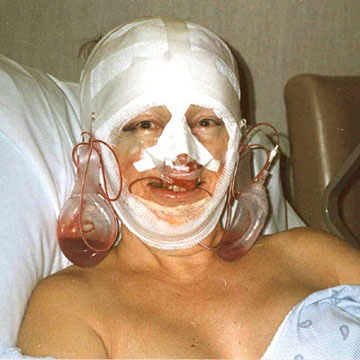
-
-
- 11-11-99: Here I am in the ACU the day after the surgery.
Dr. O has removed the full face bandages. My body has begun to
notice that something extraordinary has happened, and is reacting
accordingly. My face is very swollen now, and I've slowed down
and am settling into grinding my way through the next week or
so.
-
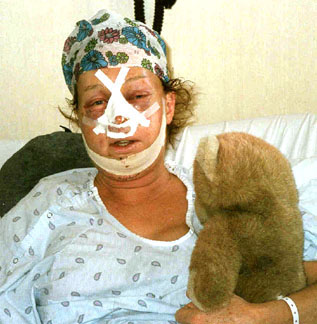
-
- This next photo is late in the afternoon of of the 11th.
My Charlie flew into SF midday, and arrived just after my full-face
bandages had been removed. I was a bit groggy here, but was I
ever so glad to see him and hug him. My face is now very swollen,
but I'm very aware that there are no major problems so far. I'm
not vomiting, my voice sort-of works, my throat isn't sore, I
can see straight and I don't feel particularly weak. Wow, I think
I got lucky - - .
-
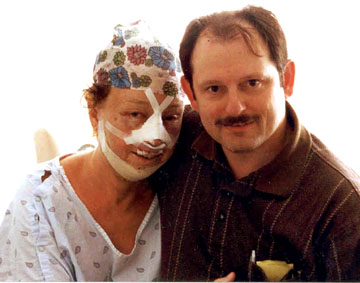
-
- Evening of the 11th. Here I am with my morphine pump
handy. It's keeping me pretty happy. Luckily I have a hearty
appetite, and the pureed food tastes great right now. I'm feeling
awake and am not in much pain now. However, I'm not totally in
contact with reality either.
-
- The facial swelling continues to increase, puffing my cheeks
way out. My hair is a soggy, bloody matted-down mess. Hmm, the
next few days are going to be interesting. Let's get some food
down while the getting's good.
-
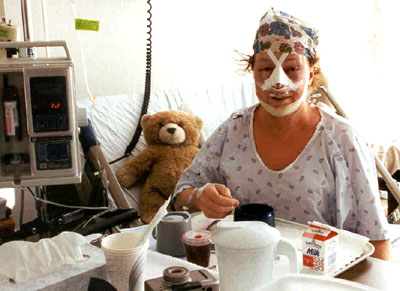
-
- I learned right away that eating was going to be a chore,
because of the nose-packing interfering with swallowing and also
the very limited amount that I could open my mouth.
-
- Then, sometime this afternoon my IV must have backed out
of its vein, because my arm started hurting. I looked at it and
saw that the forearm was all puffed up from fluid being pumped
into it. I realized what was wrong right away and called a nurse,
and she replaced the IV into my other forearm. No harm done,
but I've learned from many past surgeries that it's a good idea
to stay alert for such things, and to buzz for help right away.
-
- I'm also learning lots of wierd things, such as how wonderful
the "suction tube" is. Like the thing at the dentist's
office that sucks spit from your mouth. The problem now is huge
gooey blood clots and ooze up in behind my nose and up into my
sinuses. What makes it worse is every time you swallow anything
with the nose packing in place, some of that wants to go up in
there too! All that aggravates the psychological impact of the
darn nose packing.
-
- At first I tried to snucker that stuff down into the back
of my mouth. It was tough to do, because it was so slimy and
stuck up there. Then I accidently discovered what happened if
I stuck the suction tube back in there and caught the end of
some stuff with it. Wow, it would instantly pull a whole octopus-like
gorpy bunch of it out of there. What relief! Way cool! By the
time I left the ACU on the 12th, I'd half-filled a quart reservoir
with "stuff".
-
- Charlie stayed over at the Metro Hotel on Divisadero tonight,
the 11th. It's just a few blocks away and an easy walk to Davies.
Tomorrow when I move from the ACU into my Guest Room, Charlie
will move in with me too.
-
- The Guest Rooms are on the third floor of Davies, and although
without nursing care they are provided with hospital food services,
and are a short elevator ride and walk from Dr. O's offices.
These rooms provide comfortable, convenient, inexpensive accomodations
once ACU nursing care isn't needed.
-
- [Note: Patients (and partners) would now move to Cocoon
House, the new post-FFS recovery facility that has replaced the
Guest Rooms]
-
- 11-12/13-99: Moved from the ACU into my Guest Room
midday on the 12th. It was great to unpack a bit and get more
of my things within arms reach. What's especially wonderful is
that Charlie can now stay with me all night, sleeping in the
second bed in this room. I encouraged him to play tourist in
SF for 6 to 8 hours each day, so he'd have some fun too. But
having him return each afternoon or evening and spend the night
was wonderful.
-
- Any patient's spouse, S.O., or friend could do the same -
- you can get two keys, and the keyrings are passes through the
Davies Emergency Room area at any time, day or night.
-
- I also met JoAnne, another of Dr. O's patients today. She's
in a guest room just a couple of doors away. We were now able
to keep each other company for a while each day.
-
- The next photo shows Charlie and me in our Guest Room. The
flowers behind my head were sent by my friend Nicki. On the shelf
to the left of Charlie you'll see two "good luck" photos
that I brought with me. One is of Charlie holding one of our
cats. The other is one of my friend Sally bravely showing two
"thumbs up" while in her full-face bandage during her
surgery here.
-
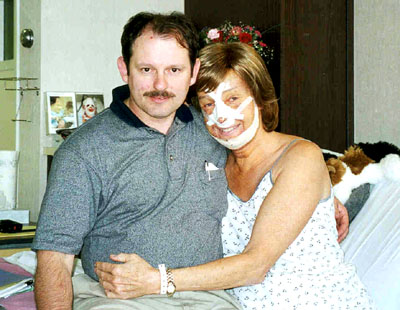
-
-
- 11-14-99: The very worst seems to be over now, and
I've settled into the grind of day-to-day coping with heavy dull
pain. Also, my nights have been pretty fitfull and I haven't
been able to sleep but for a couple of hours at a time. The bruising
on the upper face doesn't look too bad now, and the swelling
now is mainly a problem in the jaw, chin and trach areas. I've
taken on the "chipmunk" look as my friend Sally calls
it. My swollen cheeks make me look like I'm an expressionless
chipmunk with a mouthful of stuff in her cheeks - - .
-
- I've taken to walking around on the 3rd floor (the Guest
Room floor). It's 150 yards around, and is a nice, quiet relaxing
walk. You can circulate for a mile or so without seeing anyone
else, since it's almost unoccupied except for other patients
of Dr. O. You can tell how many are here by looking for food
trays outside the rooms before/after meals.
-
- I almost always left my door open, so I'd see people once
in a while. One of the food servers, undoubtedly new, once brought
my dinner into my room and said "I'm not sure what's going
on on this floor. I bring food up here and leave it outside rooms,
but never see anyone here". I said "This is the Twilight
Zone" in a very solemn voice. That seemed to reassure him
a lot.
-
- It was also very, very comforting to have a number of close
friends visiting me now. My friends Jorge and Susan visited me
yesterday; I'll be staying with them one night before flying
home on the 19th. Today Rom and her partner Luccia visited, as
did my friend Terri Wanke. I've also received lots and lots of
phone calls which, along with the visitors, have really cheered
me up.
-
- I've now begun to get into a very excited state, because
as of today I can see how amazingly this surgery is going to
affect my forehead and browridge. Along with the Vicodin pain
pills, all this has made me extremely hyperactive when on the
phone and with visitors. The nose packing and the associated
breathing and drinking difficulties are a continual nuisance,
but they didn't make me crazy or claustrophobic like I'd worried
they'd do. I'd brought a few Valiums just in case, but didn't
need to use them after all - - - .
-
- Brief description of the overall operation: Dr. Ousterhout
had made a large initial incision that accessed Lynn's forehead
and brow area. This 19 inch incision ran vertically up from the
top of each ear for about four inches, and then horizontally
circled the forward part of Lynn's scalp (the photo below shows
staples reinforcing stitches that hold together a part of this
incision). Pulling this large flap of skin downwards exposed
the forehead and browridge, part of which which Dr. Ousterhout
then sawed out and worked on outside of Lynn's head.
-
- Those forehead and browridge bones were sawed into sections,
and then reassembled with Titanium wires into a flatter form.
Dr. O then ground the surface to a smooth, convex form. After
he reshaped and resized the forehead/browridge, he wired it back
in place using Titanium wires and dissolving screws. For more
details on this unique browridge procedure, see some details
and photos from
Dr. Ousterhout's textbook.
-
- Dr. O then exploited the initial incision to advance Lynn's
hairline: He removed a section of skin and then stretched the
scalp aft of the incision forward to meet the original incision
line. Most of the incision within the hair-covered areas was
reinforced with staples after being stitched.
-
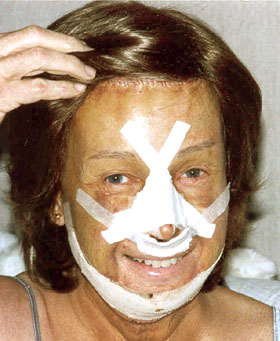
-
- In addition, Dr. O had reshaped my nose, in particular the
bone and cartilage of the nose ridge-line, so that it contoured
nicely into the new brow and forehead contours. He then made
some detailed refinements of the nose tip. In the process, he
straightened out my nose, which had been badly broken years ago
and was quite out-of-alignment left to right. In the photo above,
the nose is shown protected with internal and external splints,
internal packing and an external bandaging.
-
- The jaw and chin area is covered by a bandage compressing
the area where the jawbone has been sectioned both horizontally
and vertically. During the "double-sliding genioplasty",
pieces were taken out of the jawbone to reduce its height and
width and to change the angle of the bone underneath the chin
area. The reduced pieces were then put back together with Titanium
plates, screws and wires. Before reattachment, the jawbone was
then slid forward into a position that will yield a nice, small,
properly-positioned female chin, and then wired into place.
-
- The jaw and chin work is accomplished through a large incision
all around the base of the gums on the inside of the mouth between
the teeth and cheeks. This wound area will be quite painful for
at least two weeks after surgery, and will remain very swollen
for many more weeks after that. It's a nuisance to clean your
teeth after meals, but they have to be kept very clean to avoid
post-op infections. I'm sure glad I brought a child's tooth brush
that could easily slip down into the wound area without stretching
things too much. I think that Mira provides these toothbrushes
to most patients now.
-
- Finally, Dr. Ousterhout opened a small incision up under
my chin, through which he removed sections of tracheal cartilage
to eliminate my "adam's apple". Although mine was a
modest one and hadn't been a problem before, we knew that it
would be visibly quite obvious after my later face-lift surgery.
The trachea reduction area is also bruised and swollen in the
photo, but not too painful, yet. I didn't lose my voice during
early recovery as some have reported, although I had to keep
it rather low and soft to avoid pain from the tracheal wound
area.
-
- Even though my whole face is swollen, bruised and discolored
in the above photo, those who know me can already visualize how
much Dr. Ousterhout set my forehead back and recontoured it to
remove my browridge. Notice the higher eyebrow position, and
how much less my eyes appear to be set back into my face than
in earlier photos of me.
-
-
- Some comments on my surgical recovery so far: I was
very lucky with this surgery: I didn't step on any of the land
mines that some of the other patients have previously encountered
(extended periods of vomiting, severe sore throat from the 10
hours of intubation with a breathing tube, anxiety reaction to
the nose packing and mouth-opening restrictions, double vision
for extended periods, high-fever reaction to the surgery, loss
of voice for extended period, weight loss due to lack of appetite,
extreme tiredness for many days, etc.). Thus my appearance and
attitude returned towards normalcy fairly rapidly.
-
- However, the FFS was a major shock to my system. It was a
real grind to deal with the heavy dull pain from day to day.
You should expect major difficulties in sleeping for the first
few days, and you probably won't sleep all the night through
for the first week to ten days. My bowel movements stopped for
three days (effects of surgery and antibiotics). I'd worried
about constipation, but on the fourth day post-op I had a large
full movement without trouble (probably thanks to taking Metamucil
in some water at my morning meals each day, and a couple of Ex-Lax's
on the 3rd and 4th days).
-
- The basic activities surrounding eating are made quite difficult
due to the effects of the nose packing, the pain and swelling
in your lower gums, and the very limited amount you can open
your mouth ( I could just barely fit my thumb's smaller dimension
between my upper and lower teeth).
-
- For the first four or five days, you'll probably really need
to take a Vicodin pill once every four to six hours. You'll know
when you need to take one. After that, I reduced the dosage to
a half-tablet every six hours and then tailed that dosage off
as the days went by.
-
- Anyone contemplating this serious surgery should prepare
very thoroughly and get in good shape physically. By learning
what to expect day to day from web sites and discussions with
previous patients, one can take things to help cope with possible
problems, and one can also avoid becoming unnecessarily frightened
by and anxious about the ongoing wierd things that occur during
recovery. Visitors and phone calls are good distractions from
the daily grind while in the hospital.
-
-
- 11-15-99: Still spent a very fitfull night. Woke up
in pain, and took a Vicodin. Then got some more sleep. Felt OK
by breakfast. Sort of tired and dazed, but not too bad either.
Stomach a bit upset by a too-full feeling, since still not eliminating
quite enough to keep up with intake.
-
- Finally washed my hair for the first time this morning. Did
this by sitting and leaning back at the sink, using lots of towels,
and care not to get any of the facial bandages wet. Took a long
time even for a crude shampooing to get most of the blood and
goop out, but I felt ever so much better afterwards.
-
- Mira called and said to come to Dr. O's offices at 4pm for
first bandage/stitch removals. Charlie came with me (and watched)
as Mira removed the nose-packing, some of the inside nose stitches,
some of the trachea stiches, and the jaw/chin bandage. Dr. O
came by and he removed my forehead stiches. I'd worried about
pain from some of these procedures, but all were done very quickly
and with only minor, quite tolerable pain. I must say though
that the packing removal procedure was scary, as length after
length kept coming out. I kept wondering when it would end, and
if there would be pain somewhere along the way - - . It turned
out that the anticipation about these procedures, especially
about the removal of the nose-packing removal, was worse than
the reality.
-
- I was feeling well enough by now that Charlie and I decided
to get out of the hospital for a while. We walked from Davies
down to the N-Line Muni light-rail stop just a block away from
the hospital, and took the Muni downtown to the Powell Street
Station. We explored the San
Francisco Shopping Centre, which you can enter from that
Muni subway station without going outside. It's a neat place
to shop, and you can get there from Davies via the N-Line with
little walking or exposure to the weather (or from Cocoon House
via the J-Line).
-
- We also walked around for a while in the Market Street and
Union Square area, and browsed in some of the department stores
there. I reminisced about the time 31-33 years ago during my
transition when I drove up the Peninsula from Palo Alto each
week to undergo long electrolysis sessions in an office just
off Union Square.
-
- We took the L-line Muni subway back towards Davies, and got
off at Market and Church near the Safeway store. We bought a
bunch of deli goodies at Safeway, and walked back to our room
for a nice evening meal. I had to squash my sandwiches down flat
so that I could fit them into the side of my mouth. But it was
great to be able to eat with the darn nose-packing out!
-
- Slept better that night. Went to bed at 10pm; woke once at
12:30 to go pee; then slept all the way thru to 6:30am the next
morning. Ah that felt nice!
-
-
- 11-16-99:
-
- Felt better after the good nite's rest. Charlie packed, and
we talked a lot. He had to get back to Michigan and his work.
Went down to the lobby at 10am. His "Super-Shuttle"
arrived right on time at 10:30 to get him to the airport plenty
early for his 12:50 flight. I was sad to see him go; he'd been
wonderful through all this, and it had been quite an ordeal for
him too - - .
-
- I got a nice sandwich and some fruit at the corner mart near
Davies. Also checked out the cafeteria down on "B"
level of the hospital, and started bringing tasty items up from
there too, helping to improve my appetite again, which had finally
languished after 5 days on the hospital food.
-
- The rest of that day I spent lots of time on the phone with
friends - - and I called Charlie that eve when he got home -
- our three kitties had been lonely for us, so he gave them hugs
for me too - - .
-
-
- 11-17-99:
-
- Awoke early. Started organizing my stuff a bit, since I'll
be leaving tomorrow. About 9am, Dr. O called and asked if I could
come down early today to have him remove my nose splints (a day
early). I took a Vicodin and went down to his offices.
-
- Dr. O first removed the remaining "X" nose bandages,
and it was then time to remove the internal plastic "splints"
from way back inside of each nostril. I was quite apprehensive,
since I'd read that others had experienced great pain during
this procedure. However, although it seemed like he was pulling
large "bones" from deep inside my face out through
my nose, it didn't hurt all that much. As with the packing, the
anticipation was worse than the event. However, I was sure glad
to get that over with - - - .
-
- Dr. O then handed me a mirror, and I got my first look at
my new face. Albeit with a lot of swelling and bruising still
remaining, I was amazed at how much improvement was already visible.
The new noseridge contoured very gracefully down from the new
female browline to create a wonderful new impression. We chatted
for a while, and he carefully went over various aftercare information:
wash face with fingers (no washcloth) for a while, since the
nose is numb and you want to put even pressure of each side while
the cartilage is still soft; NO EYEGLASSES for six weeks, until
the nose cartilage firms up; no activities that would raise blood
pressure for another two weeks, after which I can resume normal
exercising; no wearing of hats that would put pressure on the
forehead bones for six weeks (bony softness must firm up first);
etc. With all the bandages finally off, I was OK'ed to take a
full shower that day (although the hospital showers are so strong
that I was still very careful not to have it directly spray on
my face and head).
-
- That evening I got really cleaned up and dressed nicely for
the first time since the operation. I put on a skirt and sweater
instead of the khaki's I'd been living in the past week. By now,
my normal make-up covered most of the bruising, and made me look
and feel better too. My friends Dick and Peggy came to visit
me, and we walked over to the Thai House, a few blocks away on
Noe Street for a great Thai dinner and a wonderful evening of
conversation. I was still very swollen and in some pain, but
it was really nice to get out to dinner with my good friends.
-
-
- 11-18-99:
-
- This morning I packed, and then went to Dr. O's offices to
have Mira remove the staples from my scalp, and to have her take
some initial "after" photos. We went over some planning
and logistics for my next trip out for the face-lift on 2-24-00.
-
- Left Davies at 11am; my friend Jorge picked me up; I'll stay
with Jorge and his wife Susan down in San Carlos tonite, and
they'll drive me to the airport tomorrow for my flight home.
-
-
- 11-19-99:
-
- After a nice evening and meal and a good night's sleep at
my friends' place, they drove me to the airport for my flight
home. It was great to get back to Michigan, and see Charlie at
the arrival gate at the airport. The trip was tiring, and I was
so glad to get home, see our kitties again, and to be able to
sleep in our own bed there. Before going to bed I weighed myself.
Amazingly, I still weighed 155#, which was my set-point prior
to deliberately gaining 5# during the two weeks before surgery.
I'd thought that I might lose more weight as, others have reported.
But that didn't happen. Now I need to work a bit to take my set-point
down to 150# , where I've wanted it to be before (and long-term
after) the face-lift surgery in February.
-
-
- 11-24-99 (2 weeks post-op)
-
- My first week home I took it very easy. I was still very
swollen in the jaw/chin area, and in some pain. I also tired
very easily. So it was a time to just relax, eat well, and get
a lot of sleep.
-
-
- 12-1-99 (3 weeks post-op)
-
- Although the swelling hadn't really gone down much, I felt
much better this week. By late in the week I resumed light work
activity, and also resumed moderate workouts at our local Y every
few days.
-
-
- 12-8-99 (4-weeks post-op)
-
- Although everything was healing well, and I was set to return
to normal activities, I hit a problem this week. On Dec. 6th
a small lump appeared at the lower right corner of my chin. By
the 7th it was quite swollen. I called Mira, and Dr. O prescribed
CIPRO.
-
- This localized infection wasn't under control by the10th,
and my face looked a little wierd due to the swollen lump under
the right side of my chin. On the 11th Doug prescribed Augmentin,
a different antibiotic. About 48 hours later the infection eased
and the swelling began to go down. Then late that day, it came
right back again! Doug reassured me that at the worst the local
infection might need to be drained to help the antibiotics work,
and that this minor procedure could be done in Ann Arbor, by
a plastic surgeon at UM Hospital who is a friend and colleague
of his.
-
- The swelling, pain and appearance effects messed up this
week for me. I mostly hunkered-down and stayed at home. So, do
not count on being "fully effective" even this long
after such major surgery. Minor complications can happen. Don't
get your activities too tightly scheduled. Be prepared to deal
with contingencies.
-
-
- 12-15-99 (5-weeks post-op)
-
- During the next week I continued on the Augmentin. Late this
week the swelling eased. Dr. O prescribed some more Augmentin
for me to take for another week, to be completely sure of clearing
the infection.
-
-
- 12-22-99 (6-weeks post-op)
-
- All signs of infection went away this week. I went off the
Augmentin mid-week and finally began to resume all normal activities.
The bony swelling in the jaw and chin is now down quite a bit,
although it is irregular and lumpy in places. Almost all the
bony pain is gone now. My chin was still quite numb, but my lower
lip was more sensitive again so that I didn't "drool"
as much when I eat. I still couldn't open my mouth very wide
(only 20mm), so eating still involved cutting things into small
pieces and inserting things into the side of my mouth.
-
- My appearance when made up, happy and smiling was very nicely
feminine now. Even given the limitations due to healing and recovery,
and how funny and sore my face felt to me, many people at gatherings
felt compelled to comment on "how well I look!" Folks
clearly noticed nice changes, but weren't able to interpret them
and figure out what happened. They're thinking maybe I've lost
weight since they saw me last? Or perhaps I've been doing a lot
of exercising? I also caught glimpses of acquaintances staring
at me in profile in a state of slight confusion. They were probably
trying to figure out why their recollections were so far off-base.
It was fun to experience these reactions, which helped to keep
the smile on too!
-
- 12-29-99 (7 weeks post-op)
-
- The jaw and chin swelling dropped off rapidly this week.
There were still a few random bumps of swelling left, but I'm
finally seeing what the jaw and chin will eventually look like.
It's wonderful! I couldn't be more pleased. The reduction is
far more than I'd originally thought could be done, and the appearance
of the chin is really very cute. Also, the banding and swelling
from the tracheal wound went down a lot, and I could now also
see how much Doug reduced my tracheal "bump". It's
gone completely, and there will be nothing but a nice smooth
neck contour showing once the face-lift is done. Wow, I ever
so thrilled with the results now! I should post some photo updates
sometime soon - - .
-
- 1-10-00 (2 months post-op)
-
- Back to near normalcy now. There is still some lingering
jaw swelling and numbness in my chin and left cheek, and some
"banding" in my neck tissues where the trach incision
was made. The swelling is down enough now to get me worrying
again about needing the face-lift.
-
- 2-10-00 (3 months post-op)
-
- Almost time to go back to Davies for the face lift on Feb.
24th. And it's a good thing: As the FFS swelling went down further,
the need for a face-lift became ever more obvious. A lot of new
wrinkles and sags are showing now, unless I keep a big smile
on my face!
-
- On the other hand, I'm finally able to open my mouth much
wider ( 30mm ), and can thus eat things more normally, including
eating sandwiches without flattening them first!
-
-
-
- LYNN'S INITIAL
FFS SURGICAL RESULTS:
-
- This section provides some photos of and comments on the
results of my FFS surgery as the results become increasingly
evident during longer-term recovery.
-
- First we'll see some initial "after photos" taken
of me on Nov. 26th, when just 2-weeks and 2-days post-op. It's
amazing how fast I'd been healing just the prior few days. I'm
still quite weakened at this point, and have to take it easy.
But, almost all bruising and discoloration have disappeared over
the last couple of days. What's left can be easily covered by
regular make-up.
-
- Of course, there is still very heavy, hard swelling underneath
the jaw and chin, which shows up as large lumps in the following
photos. There is still quite a bit of numbness in the lower lip,
lower jaw and chin, and also in the forehead and brow area. As
the numbness gradually recedes it is replaced by dull heavy pain
and a wierd tinglyness as the nerves begin to recover their functions.
As of this point, I can't yet control my lower lip movements
or my chin's facial muscles, making the effects of the swelling
much more noticeable in person than in photos.
-
- However, I am thrilled at the results we're seeing, even
now at this very early stage with LOTS of swelling and pain remaining
(mainly in the jaw/chin area). My friends will immediately see
the huge difference in my appearance in profile. I've never ever
shown photos of me before in profile, or even front-on photos
without my hair down over my forehead. The elimination of my
old browridge, recontouring of forehead and nose-ridge, and reduction
in size and narrowing of the chin changes all that.
-
- I can't wait to see how it's all going to look when the jaw
and chin swelling goes down completely. Dr. Ousterhout really
performs miracles with his FFS surgeries. Time will tell, but
I think he's done it again - - for me.
-
|
Nov. 26, 1999: Lynn at 16
days post-FFS (still with LOTS of
jaw/chin swelling) |
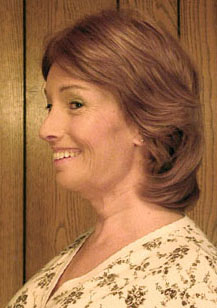
|
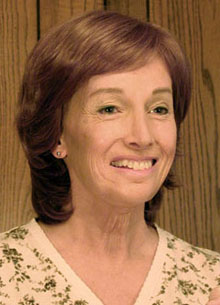 |
-
-
- Also, I noticed a very interesting side-effect of the noseridge
and browridge reduction: My peripheral vision has been greatly
extended up, to the sides, and (in binocular vision) across the
nose, because those bony areas are no longer blocking so much
of the view. It's like shifting from an older car into a newer
one that has a much wider, higher windshield.
-
- As an update, here are some snapshots, including one of Charlie
and me at Christmas dinner while visiting with my brother and
his wife in Wisconsin, and another taken in San Francisco in
February. Even though these photos are limited in resolution,
my new facial contours are quite noticeable in the semi-profile
views taken at 6-1/2 weeks post-op and 3-1/2 months postop:
-
|
Charlie and Lynn, December
25, 1999 |
February 22, 2000 |
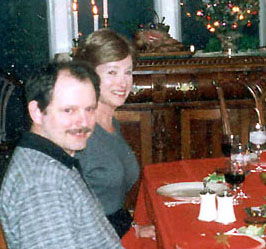
|
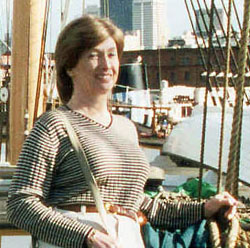
|
-
- Of course, there's still some more to do to complete my FFS
project. It takes several months for the bony swelling to shrink
back to where it's not noticeable. With that shrinkage, all the
bone removal means that I must get a face lift, because at my
age my skin will not shrink back all the way as the swelling
goes away. You can see the loose skin down in the front of my
neck and around my eyes in the detailed 2 weeks + 2 days "after
photos" above. For a while, in late January and February
of '00, I'll actually look lots older because of all that loosened
skin. However, that problem will be solved by Dr. Ousterhout
on Feb. 24, 2000, when he works on me for another 6 hours on
the operating table to do my face-lift and some skin-tightening
around my eyes.
-
-
-
- LYNN'S FACE-LIFT
SURGERY (FLS) DIARY:
-
- In many older patients, face-lift surgery may be necessary
as a follow-up to FFS. Some patients may have already needed
a face-lift prior to FFS, and/or their facial skin may not adequately
shrink and tighten up after the FFS's reduction of facial skeletal
dimensions. In such patients, a face-lift can produce dramatic
overall results, making them not only look more feminine, but
much younger too.
-
- Dr. Ousterhout requires a wait of at least a 3 months after
FFS before doing the face-lift surgery, in order to insure adequate
reduction in bony swelling after FFS. During the final month
or so of that wait, you will not look your best due to all the
wrinkles and sags. By then you'll be highly motivated to get
on with the face-lift!
-
- On February 24, 2000, Lynn underwent face-lift surgery and
blepheroplasty (upper and lower eyelid surgery) by Dr. Ousterhout
at Davies Hospital in San Francisco. For a detailed diary regarding
this surgery, including photos and tips and hints, see the following
subpage:
-
-
-
- The physical impact of face-lift surgery was far less severe
than was FFS. Readers can see the difference for themselves by
comparing the photos of me during early recovery at that face-lift
site, with those of me during early FFS recovery. The first four
days or so after FFS were quite an ordeal. The photos taken during
early FFS recovery show me in great pain, with an extremely swollen
face, grimly hanging on and sweating-out the passage of time.
In contrast, the photos at the Face Lift page show me bouncing
back pretty quickly during early recovery. While there was pain,
bruising and swelling after the face-lift surgery, it was quite
tolerable and nothing in comparison with trauma of the initial
FFS.
-
|
Here we go again! Lynn shortly
after face-lift surgery, February 24, 2000 |
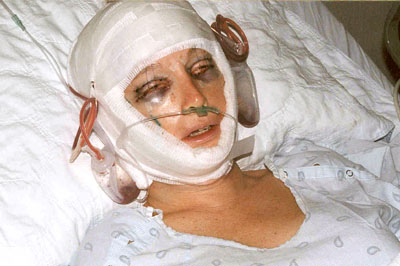
|
-
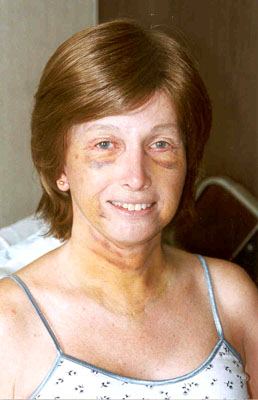
|
Five days after her face-lift
surgery, Lynn is feeling just fine.
February 29, 2000 |
-
- The face-lift and eye-lid surgery put the "frosting
on the cake", and a few weeks later the amazing overall
results of the FFS and FLS surgeries were finally revealed.
-
-
-
- LYNN'S OVERALL
FFS/FLS SURGICAL RESULTS:
-
- Following are digital camera snapshots of my FFS/FLS results,
taken March 29, 2000. My facial skin is still very tight, and
there's still some minor bruising and some swelling remaining
in my cheeks at 5 weeks postop from the face-lift surgery. Although
I'm having a little trouble smiling and making facial expressions,
the overall results of the surgeries are now becoming clear.
-
- I'm very thrilled with these results, which not only make
me look very female but also much younger than my actual age.
The effect of FFS on feminizing my profile seems almost unbelieveable
to me. Then the face lift removed the jowls in my cheeks and
large wrinkles in my face, and also the "turkey neck"
folds of skin under my chin. The blepheroplasty removed the large
bags of skin over and under my eyes. I'll probably undergo laser
resurfacing to reduce the finer facial wrinkles too, but that
will wait for another year or so. Doug has worked his miracle
for me, and it's truly wonderful!
-
- March 29, 2000: Lynn at 4-1/2 months post-op from FFS, and
5 weeks postop from face-lift surgery
- [Lynn's skin is very tight, and she's
having trouble smiling, but the results
look great already]
|
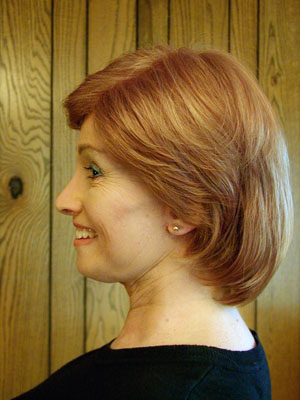 |
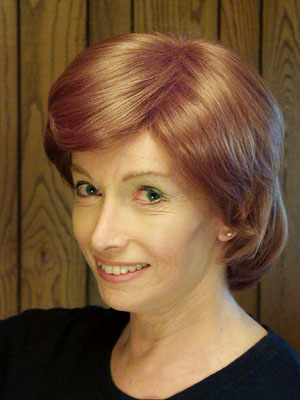 |
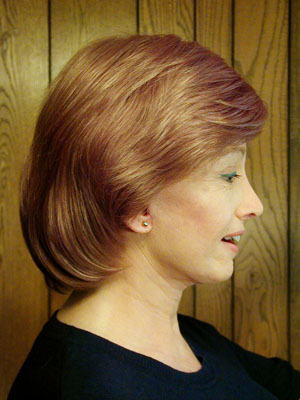 |
-
-
- Following is a photo taken two months later, on May 29, 2000.
My skin isn't so tight now, and I've been getting used to how
my new face "works". I've been exercising my facial
muscles a lot, and I can make more relaxed, natural smiles and
a normal range of nice facial expressions again. Now the result
looks really wonderful to me!
-
-

